Ambient chord progressions
2019-12-20 composition music
I get a lot of questions about ambient chord progressions. Actually, I don't get any questions about ambient chord progressions. What I get is search engine traffic from people who were looking for that on the Net, and end up reading my old article about fractal chord progressions, which may or may not be much help to them.
Part of the issue, and maybe part of the reason people are searching for this, is that there is not really such a thing as an "ambient" chord progression. Chord progressions are not what makes music ambient! Ambient music is intended to go on in the background while the listener is focused on something else. It's music that doesn't draw attention to itself. The way to achieve that often has a lot more to do with other things, like rhythm, melody, orchestration, voice leading, and other details that aren't really part of what's usually called a "chord progression". You can write ambient music with any chord progression, and no chord progression will automatically make your music ambient. It may not even make sense for ambient music to have a chord "progression" in the usual sense, based on functional harmony and concepts like resolution, at all. We usually want ambient music to sort of circle around without sounding like it's making progress.
Nonetheless, there are some things we can do with the sequence of chords that might help make the music ambient, so here's a grab bag of ideas. I'm including audio examples made with a software synth and the Precisionsound D-85 sample library. I've tried to make the examples as simple and as consistent as possible: just an identical two-bar riff played repeatedly over the progression in question to make up twelve bars. This is far from being great ambient music, but that's not the point. The idea is to be able to compare the different progressions while controlling out as many other variables as possible.
First, some theory
In understanding harmony it's useful to arrange the twelve notes of the octave into a circle, called the circle of fifths or circle of fourths , where each note is a fifth (going one direction) or a fourth (going the other way) from the neighbouring note. Notes that are near each other on this circle sound similar in terms of harmony; you can often replace a note with its neighbour and not much will change in the sound, even though they are far apart in terms of fundamental frequency - and notes that are close together in frequency, such as C and C#, are actually quite far apart for harmonic purposes and you'll notice that kind of substitution.
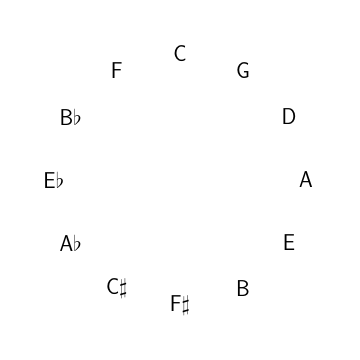
There is more complexity possible. In particular, the assumption of twelve notes equally spaced in the octave is not absolute. it's valid for many instruments and very much music but there are also musical theories based on not having that assumption. The direction of the drawing the circle is of course arbitrary and in an earlier version of this posting I drew it the other way around, but I have updated the graphics to flip it around (preferred resolution going counterclockwise) in order to agree with some other sources.
Also, there's some weirdness which I don't want to go into very much in this article having to do with notes having more than one name, or names that may or may not be considered the same: like C# and D♭. Are those the same note? They are the same key on the piano. Formally, C# is the note immediately clockwise (one fifth up) from F#, whereas D♭ is the note immediately counterclockwise (one fifth down) from A♭. On the twelve-note circle they end up in the same place and are really the same note - I have written C# but it's understood that if I say D♭ I mean the same note. More advanced theory might try to keep them separate and expand the circle into a spiral; but in this article, especially with chord progressions like the ones I'm talking about here that aren't really based on functional theory and that loop around the circle entirely, it makes most sense to assume that so-called enharmonic notes really are exactly the same things. When I write C# or D♭ I mean the same note either way. I hope I won't confuse anyone by saying that the whole matter is a lot like the International Date Line.
If music is in a "key," it will normally be associated with a diatonic scale that consists of seven consecutive notes on the circle. For instance, the C major scale, which is the same as the A natural minor scale, consists of the notes A through G without sharps or flats.
It's easy to derive the notes of any other diatonic scale from the diagram - they will always be a set of seven consecutive entries. For instance, the D major scale is all the notes from G clockwise to C#, or in alphabetical order A, B, C#, D, E, F#, G.
For music that is in a specific key (not all music is!), most if not all the notes will be from the corresponding scale, and most if not all of the chords will be made up of notes from the scale. For any of these scales you get three basic major triad chords and three minor triads as well as one diminished triad: overall, one triad starting on each note of the scale. And the pattern is the same for any key. You just shift around to the appropriate place on the circle. In the key of C major or A minor, the basic chords you get at F, C, G (major - chord symbols usually use just the note name to indicate a basic major chord); Dm, Am, Em (minor chords designated by "m"); and Bø, the diminished chord. C major and A minor are in some sense the same key; the difference between the two will be in whether the music focuses on the C or the Am chord as the more common destination of its movement.
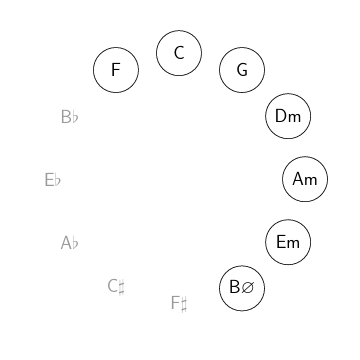
There is a natural tendency for chords to be pulled counterclockwise around the circle, one step at a time, and chord progressions often tend to make their "progress" with that kind of move. After you play a D chord, it feels very natural for the next chord to be G. This is not the only thing that drives chord progressions, and in some cases other forces will tend to draw the ear more strongly in some other direction. But the drive from the fifth to the root to the fourth, that is counterclockwise around my diagram, is pretty significant. It becomes stronger in the case of major chords, and when moving away from a seventh chord or moving onto the chord that names the key. If you're in the key of C major and you play a G7 chord, then the listener will really want to hear the C chord next; and when that C major chord hits, it feels like the music has come to rest with the "tension" being "resolved."
In ambient music, maybe we don't want to really do that.
Just one chord
Ambient music is often music that kind of goes nowhere, and maybe the easiest way to do that is with a chord progression that literally goes nowhere. Just pick your favourite chord and stick to it. You can make it slightly less boring by having several different voicings of the same chord - but remember that to be "ambient," music should maybe be a little bit boring anyway. Some of my favourite chords are B major, A minor, and E major add nine. Here are samples of each of those.
With these or any of the samples in this article, click on the title to go to the corresponding audio server page, where there are links for the downloadable MP3 and FLAC versions and PDF sheet music. I've also posted a ZIP file containing the MIDI files that were used to render these samples; note the files are not General MIDI and won't sound the same on a General MIDI synthesizer. They were written for the TiMidity++ software synth using the Precisionsound D-85 sample library and the configuration file included in the package.
Circling around
To get some motion in the music, but still not have the kind of "resolution" that would attract attention and bring the music out of the background, maybe we can make small steps around the circle, going clockwise. It takes a full twelve chords to make a complete cycle, but in principle we could keep up this circle-of-fifths progression indefinitely. Here's what it sounds like, with basic minor triads: Cm-Gm-Dm-Am-Em-Bm-F#m-C#m-A♭m-E♭m-B♭m-Fm (and then back to C). In fact it might well sound even more "ambient" with more complicated chords that to some extent hide the harmonic changes.
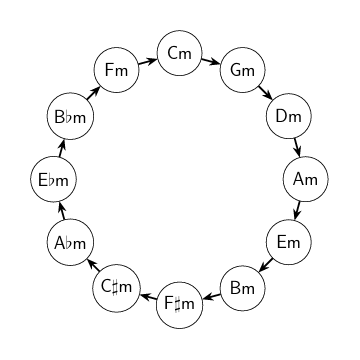
Normally if trying to invent an "ambient chord progression" we'd avoid moving to the fourth, because that sounds like a resolution, and especially avoid playing a seventh chord and then moving to the fourth of that. But it might be a fun idea to hang a lampshade on that seventh-chord-to-fourth resolution: instead of avoiding it, do it every time, stepping around the circle in the counterclockwise direction, with all the chords being dominant sevenths. The idea is that with this kind of resolution at such frequent intervals, the listener will become habituated to it and it will stop grabbing attention.
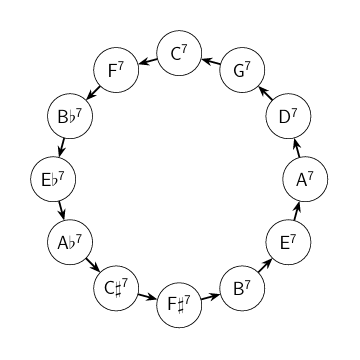
Fractions of the octave
Twelve notes in the octave allows for uniformly stepping around it in several different ways. Moving one place around the cycle at each step gives twelve steps to make a circle, which is a little long for a chord progression, but with longer steps we can make a cycle of two, three, four, or six chords instead.
Just jumping between two chords diametrically opposite (that is, a tritone apart) gives an intesting texture. The gap between a chord and its tritone-opposite is pretty significant, so you hear the switch, but with it happening regularly and frequently it goes partway into the background, like the circle of fourths progression. In my example I'm using C and F#, but obviously any pair of chords that are opposite each other could be used.
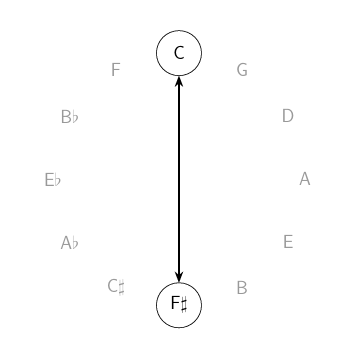
Fractional-octave cycle (tritone)
Moving four places around the circle of fourths or fifths gives a cycle of three chords each a major third from the next. I'd be inclined to do the steps clockwise, with major chords, so that each chord contains the root of the next. That makes the transitions stand out less. Then the cycle of chords is E♭-G-B (the one in my audio example); C-E-A♭; D-F#-B♭; or A-C#-F.
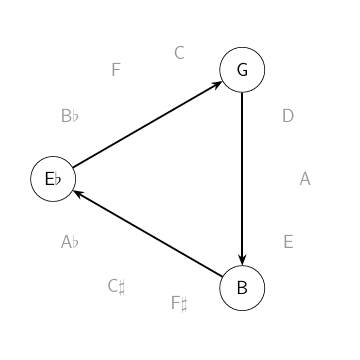
Fractional-octave cycle (major thirds)
Similarly, moving three spaces on the circle at each step gives a cycle of four steps before we return to the starting point, and each chord root is a minor third from the last. I'd do this one in a counterclockwise direction, and use minor chords, again so that each chord will contain the root of the next. My example is A♭-B-D-F, and the other two possible cycles are B♭-C#-E-G and C-E♭-F#-A.
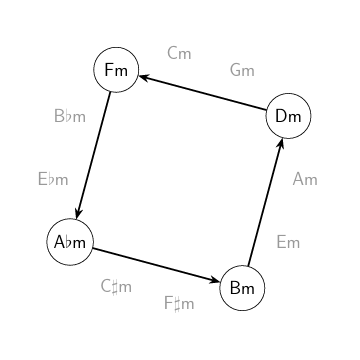
Fractional-octave cycle (minor thirds)
Finally, by moving just two spaces around the circle at each step we get a cycle of six steps, separated by major seconds. I used minor chords in my example but it could sound good with any quality of chords; suspended chords might be worth trying because using them will guarantee an overlapping note between successive chords in the cycle.
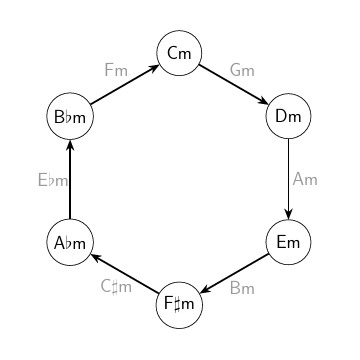
Fractional-octave cycle (major seconds)
Good old vi-IV-I-V
Any of these cyclic progressions that go around the entire octave will tend to be atonal: they don't stay in one key. To some extent that may be desirable for ambient music, but a different approach might be to try to find some kind of progression that will be tonal and stay in a key, but still have the endless resolution-avoiding feeling. The old reliable vi-IV-I-V progression is good for that. I've used it a lot in projects like my earlier thing on fractal progressions.
The vi-IV-I-V progression consists of a minor chord on the sixth note of the (major-key diatonic) scale, then major chords on the fourth, first or root, and fifth, in that order, before returning to the beginning. It is often called an "heroic" progression for the feelings it's associated with in classical music and film scores. Marc Hirsh dubbed it the "sensitive female chord progression" for its popularity with the Lilith Fair types - very many singer-songwriter hits of the 1990s were written with this chord progression. For example, Joan Osborne "What if God was one of us?"; Melissa Etheridge "Angels would fall"; and Sarah McLachlin "Building a mystery," which has the interesting variation of an added ninth on the IV chord. That was one of the songs that first got me into added ninths.
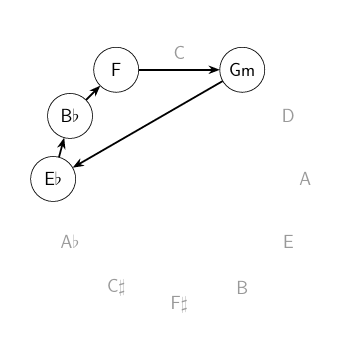
The diagram shows what's going on in this progression: it steps through the three major chords of the key (E♭, B♭, and F in the key of B♭ shown here) making clockwise moves - never doing the counterclockwise "resolution" thing that listeners recognize as a stopping place. Then it detours through one of the minor chords (Gm here) before returning. The progression has an endless quality because of this lack of resolution, and there's an added benefit that these chords happen to work out well for the voice leading. You can choose voicings for each chord so that none of the notes move very much from each chord to the next, and moreover, there are reasonable choices that can be made to shift the overall pitch slowly up or down, which is good for adding variety in songwriting even though strictly speaking it's beyond the scope of just a "chord progression." I tried to demonstrate the pitch-shift voicing in my brief sample clip.
Avoiding the key note
Here's a more experimental attempt at building a progression that will be tonal and stay in a key, but still sound somehow "ambient." The idea is to approach the key chord in two directions but never quite hit it, always jumping to the other side instead.
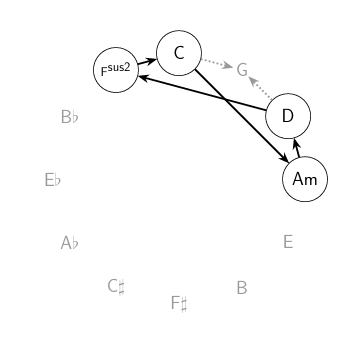
My sequence of chords is D-Fsus2-C-Am, in the key of G. In Roman-numeral notation that would be V-♭VIIsus2-IV-ii, but I think the picture is easier to understand - and from the picture it's easy to figure out the chords for this progression in any other key. I wanted to use major chords on either side of G, making G the key note whose chord is never actually played, but doing that means F is out of key; it is the flatted seventh, whereas the properly in-key seventh for the key of G major is F#. Using a sus2 chord for the F chord allows it to sound not very out of key because the second that makes up the sus2 chord is key note G after all. Using a major chord with added second or ninth would also work instead of the sus2. I wouldn't use a full ninth chord (that is, also including the seventh) because it would want to go further counterclockwise to B♭.
Spooky chromaticism
Yet another idea is to give up on tonal harmony altogether and just create a mood with the pitches. Slowly going up and down by a semitone feels kind of creepy and uncomfortable, like cold skeleton fingers on your spine - an effect more often used with melody, but we can try it with chords as well. In this case I'm starting on E♭ and going down to D and up to E, all with minor sixth chords, which sound a bit eerie all by themselves. That's not always the ambience we might want, but it's certainly one kind of ambience.
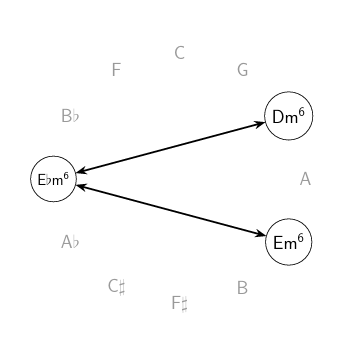
One neat thing about this kind of "progression" is that it doesn't even really need to be a change in the chords. On a modular synthesizer, it's easy to hook up a slow LFO and a precision adder, such as the North Coast Synthesis Fixed Sine Bank and Dual VC Octave Switch, to smoothly shift the pitches of the music up and down by about a semitone automatically while the sequencer just stays on a single chord.
Further thoughts
That's twelve examples of what might be called "ambient chord progressions" and I hope they're of some help. As I mentioned at the start, though, I think what really makes ambient music is not chord progressions at all, but other things like voice leading. The inimitable "8-bit Music Theory" has done a couple of good videos on ambient techniques in video game music and I recommend watching them: "4 Tips for Writing Ambient Chord Progressions" (featuring the music of Donkey Kong Country), and "Nonfunctional Harmony in Chrono Trigger." The videos go into a fair bit more advanced stuff, and don't focus on chord progressions so much.
◀ PREV Toronto Sound Festival || Middle Path VCO development gallery NEXT ▶
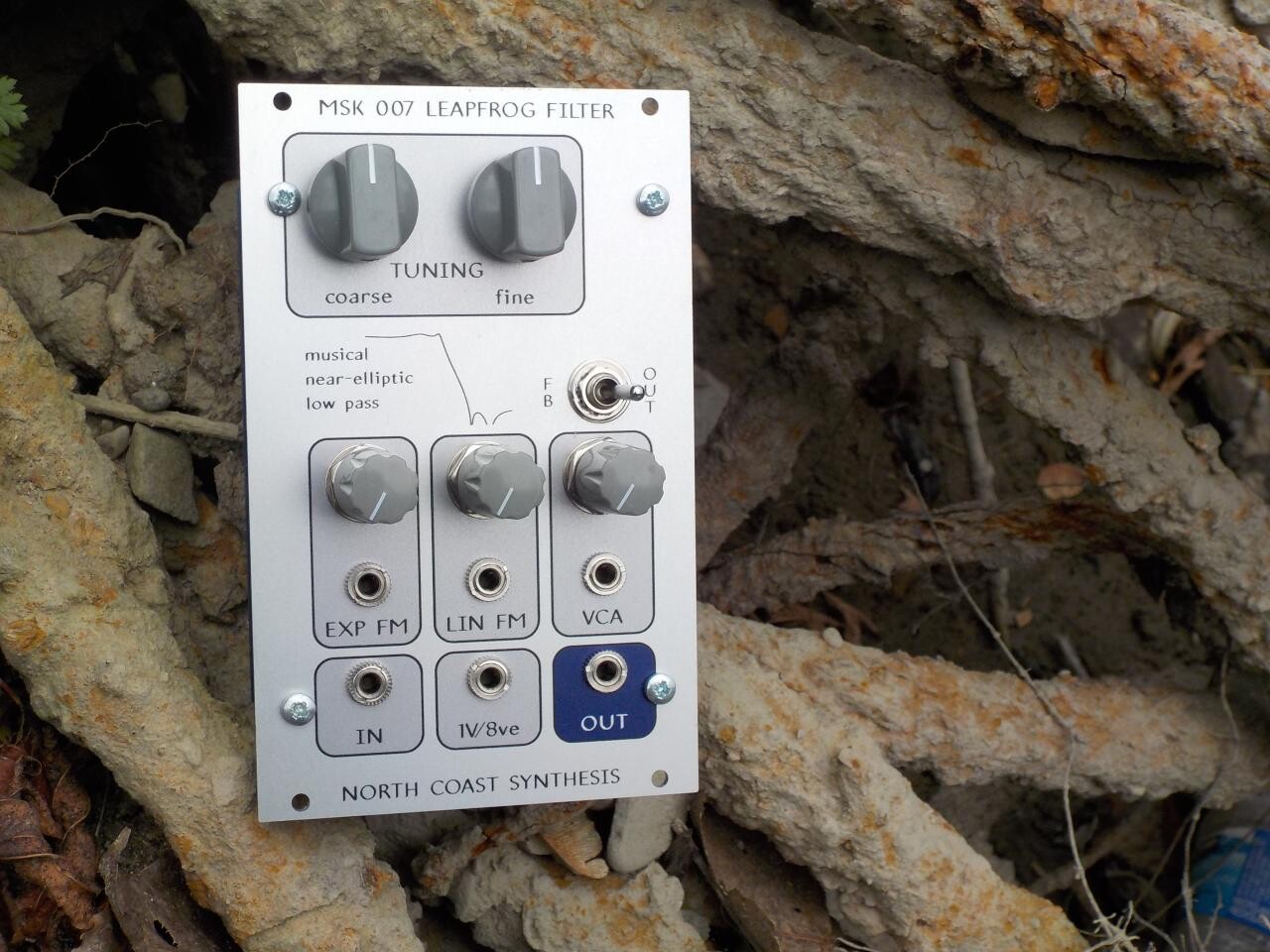
MSK 007 Leapfrog VCF
US$389.37 including shipping
Comments
Do be aware, as I mention in the text added to the article, that these are not General MIDI files; they were written for the software synth and commercial sample library I was using.
If by ambient music, you mean something that lets you zone out, I think that it should work much better to imitate the feeling that you get when you're about to fall asleep, of rocking back and forth, by making a chord progression that goes back and forth (while avoiding strong resolutions).
Totally agree on the 8 Bit Music Theory recommendation!